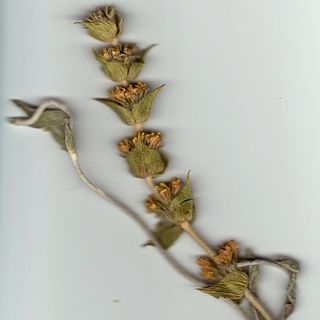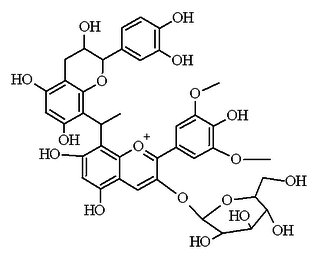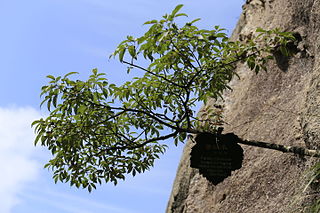
Vitis vinifera, the common grape vine, is a species of flowering plant, native to the Mediterranean region, Central Europe, and southwestern Asia, from Morocco and Portugal north to southern Germany and east to northern Iran. There are currently between 5,000 and 10,000 varieties of Vitis vinifera grapes though only a few are of commercial significance for wine and table grape production.

Eucommia ulmoides is a species of small tree native to China. It belongs to the monotypic family Eucommiaceae. It is considered vulnerable in the wild, but is widely cultivated in China for its bark and is highly valued in herbology such as traditional Chinese medicine.

Gmelina arborea,, locally known as gamhar, is a fast-growing deciduous tree in the family Lamiaceae.

Sideritis, also known as ironwort, mountain tea, and shepherd's tea, is a genus of flowering plants known for their use as herbal medicine, commonly as a herbal tea. They are abundant in Mediterranean regions, the Balkans, the Iberian Peninsula and Macaronesia, but can also be found in Central Europe and temperate Asia.

Millettia laurentii is a legume tree from Africa and native to the Republic of Congo, the Democratic Republic of Congo, Cameroon, Gabon and Equatorial Guinea. The species is listed as "endangered" in the IUCN Red List, principally due to the destruction of its habitat and over-exploitation for timber. Wenge, a dark coloured wood, is the product of Millettia laurentii. Other names sometimes used for wenge include faux ebony, dikela, mibotu, bokonge, and awong. The wood's distinctive colour is standardised as a "wenge" colour in many systems.
Acmella leucantha is a species of flowering plant in the family Asteraceae. It is endemic to Ecuador, where it is known from three locations in the Andes and one on Puná Island. The Andean subpopulations grow in forests and the dry vegetation of mountain valleys. The island subpopulation occurs in coastal habitat. The species is threatened by habitat destruction, including deforestation on Puná Island.
Lithodora nitida is a species of flowering plant in the family Boraginaceae. It is endemic to Spain. It is known by the common name viniebla azul.
Meriania leucantha is a species of plant in the family Melastomataceae. It is endemic to Jamaica.
Shorea seminis is a species of tree in the family Dipterocarpaceae. It is native to Borneo and Palawan.
Millettia leucantha or sathon is a species of plant in the legume family, Fabaceae. It is a perennial flowering tree native to Indo-China – Cambodia, Laos, Myanmar, Thailand, and Vietnam – as well as Bangladesh and southern Yunnan province in China.

Cucurbitacins are a class of biochemical compounds that some plants – notably members of the pumpkin and gourd family, Cucurbitaceae – produce and which function as a defense against herbivores. Cucurbitacins and their derivatives have also been found in many other plant families, in some mushrooms and even in some marine mollusks.

Chrysanthemin is an anthocyanin. It is the 3-glucoside of cyanidin.
The molecular formula C23H24O12 (exact mass: 492.12677623) may refer to:

Malvidin glucoside-ethyl-catechin is a flavanol-anthocyanin adduct. Flavanol-anthocyanin adducts are formed during wine ageing through reactions between anthocyanins and tannins present in grape, with yeast metabolites such as acetaldehyde. Acetaldehyde-induced reactions yield ethyl-linked species such as malvidin glucoside-ethyl-catechin.

Flavanol-anthocyanin adducts are formed during wine ageing through reactions between anthocyanins and tannins present in grape, with yeast metabolites such as acetaldehyde. Acetaldehyde-induced reactions yield ethyl-linked species such as malvidin glucoside-ethyl-catechin.

Hypolaetin is a flavone. It is the aglycone of hypolaetin 8-glucuronide, a compound found in the liverwort Marchantia berteroana. Hypolaetin 8-glucoside can be found in Sideritis leucantha.
S. leucantha may refer to:

Sideritis cypria, the Cyprus ironwort, is a species of flowering plant in the family Lamiaceae. Erect perennial herb with a woody base, 60 cm high, with densely hairy tetragonal shoots. Leaves, opposite, simple, obscurely serrate, densely hairy, thick, oblanceolate, 3-12 x 1–5 cm. Flowers in verticillasters subtended by the cup-like bracts, zygomorphic, corolla bright yellow. Flowers from June to August. Fruit of 4 nutlets.

Sideritis hyssopifolia, hyssop-leaved mountain ironwort. A 40 cm high shrublet with narrow pointed leaves. The flowers (1 cm) are borne in dense cylindrical clusters from broad spiny-toothed bracts. The calyx also has spiny teeth. Flowers June–August. Its IUCN Red List Category is least risk.

Fraxinus insularis, the Chinese flowering ash or island ash, is a species of flowering plant in the family Oleaceae, native to central and southeastern China, Hainan, Taiwan, the Ryukyu Islands, and Yakushima, Japan. Its leaves produce a number of secoiridoid glucosides.














